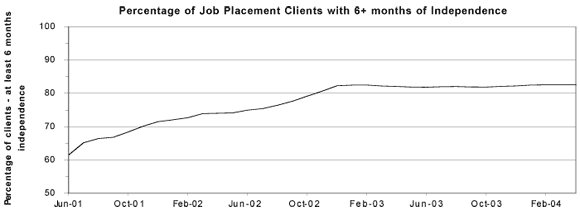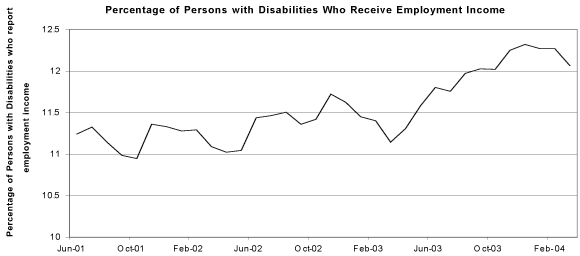Goal 1
BC Employment and Assistance Clients Achieve Independence Through Sustained Employment.
Core Business Area: Employment Programs
Objective 1
Clients find employment through work search and job placement services.
Key Strategies
Refer clients to the Job Placement program.
Performance Measures and Results
Measure 1.1: Percentage of Job Placement clients who remain independent of income assistance for at least six months.
| Performance Measure |
2003/04 Target |
2003/04 Actual |
Variance |
Target Achieved |
| 1.1 Percentage of Job Placement clients who remain independent of income assistance for at least six months |
80% |
84.4% |
+4.4% |
Yes |
The Job Placement program was designed to assist the most job-ready clients to obtain sustainable employment. Depending on client needs, service providers delivered a range of pre-placement, employment placement and post-placement services and supports. All Job Placement program contracts were performance-based. Service providers received payments when they placed clients in jobs and supported them to maintain employment and remain independent of assistance.
The key element of success in the Job Placement program was that clients find and sustain employment. To determine the success of this program the ministry measured the percentage of clients who achieved six months of independence after being placed in a job by one of the Job Placement program contractors.
In 2003/04 the ministry achieved and surpassed the target set out for this performance measure. This program continues to contribute to the ministry's success in achieving independence for clients through sustained employment. Since June 2001, over 28,000 Job Placement program clients have achieved independence.
Historical Context
Since its introduction clients have increasingly achieved at least six months of independence from income assistance through the Job Placement program. The time series graph below shows that in June 2001, 61.4 per cent of clients achieved this milestone and the rate of client success consistently rises over time. This success is a result of client actions, program refinement and the ministry's continued emphasis on employment and self-reliance.

Objective 2
Clients acquire specific job skills through targeted training for employment.
Key Strategies
Refer clients to the Training for Jobs pilot program.
Performance Measures and Results
Measure 1.2: Percentage of Training for Jobs clients who remain independent of income assistance for at least six months.
| Performance Measure |
2003/04 Target |
2003/04 Actual |
Target Achieved |
| 1.2 Percentage of Training for Jobs clients who remain independent of income assistance for at least six months |
Establish Baseline |
70% |
Yes |
The Training for Jobs program focused on providing people who have barriers to employment with the specific skills and job placement opportunities they needed to gain sustainable employment. Contractors identified specific training needs, trained people, placed them in jobs and provided job retention supports and services. The success of the Training for Jobs program is measured by the proportion of clients with barriers to employment who became independent of income assistance for at least six months.
This measure is similar to the Job Placement program's measure with a lower baseline. This lower baseline reflects the fact that clients participating in Training for Jobs faced more barriers to employment, in general, than clients who participated in the Job Placement program. It also reflects some design differences between the two programs.

Objective 3
Persons with disabilities who seek work are supported through employment programs.
Key Strategies
Implement the second phase of the Employment Strategy for Persons with Disabilities.
Performance Measures and Results
Measure 1.3: Percentage of Persons with Disabilities with employment income.
| Performance Measure |
2002/03 Target |
2002/03 Actual |
2003/04 Target |
2003/04 Actual |
2003/04 Variance |
Target Achieved |
| 1.3 Percentage of Persons with Disabilities with employment income |
11.2% |
11.0% |
11.5% |
12.1% |
+0.6% |
Yes |
The Employment Program for Persons with Disabilities (EPPD) provided employment supports and specialized job training and job placement services. The Employment Program for Persons with Disabilities assisted persons with disabilities to participate in employment-related activities to the best of their ability. This program recognized that individuals experience disabilities in varying degrees, at different stages of their lives. The EPPD included Pre-Employment Services, Planning and Employment Services, Self-Employment Services, Disability Supports, and Assistive Technology. The EPPD provided a comprehensive approach to employment programs for persons with disabilities that is unique to British Columbia. The program was implemented in September 2003 and was delivered through contracted resources.
Voluntary Participation Plans (VPP) were introduced in June 2003. The VPP was a planning tool for clients who did not have employment-related obligations but who wished to access ministry employment services and programs. By entering into a VPP, Persons with Disabilities were provided an opportunity to participate in programs which enhanced their employability. These plans assisted Persons with Disabilities to find employment and decrease their dependence on assistance.
Effective April 1, 2003, the ministry increased the earnings exemption for Persons with Disabilities from $300 to $400 per month. Earnings exemptions allowed Persons with Disabilities to keep a portion of their after-tax employment income. These exemptions were designed to encourage Persons with Disabilities who were able to work to maintain their skills, participate in the workplace as best they can, and have a greater financial independence. The increased exemption and the introduction of the EPPD and VPP all contributed to the ministry surpassing this performance measure target.
Historical Context
Persons with Disabilities have increasingly reported employment income since June 2001. The time series graph shows the success of clients who achieved more self-reliance through the reporting of income. Factors contributing to this increase were the earnings exemption, the supports of the Employment Strategy for Persons with Disabilities and the Voluntary Participation Plan. This graph shows that income reported varies throughout the year. This was attributable, in part, to the cyclical ability of some persons with disabilities to have ongoing employment.

|
